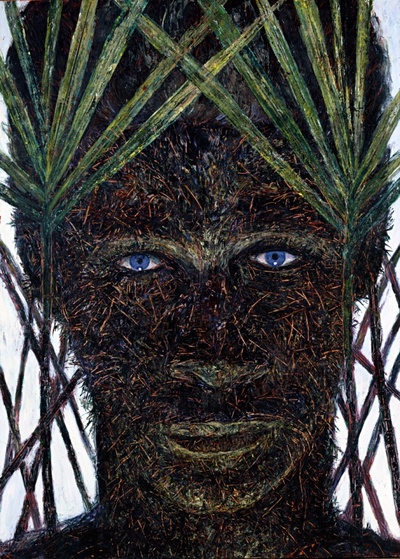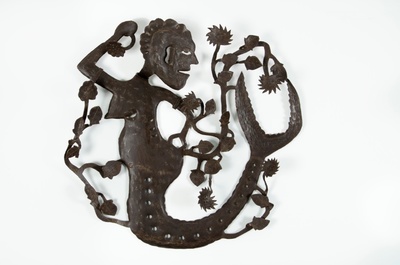Defining Caribbean Crossroads of the World
By Bansie Vasvani
Caribbean: Crossroads of the World, an expansive, multi-venue exhibition in New York at The Studio Museum in Harlem, the El Museo del Barrio, and the Queens Museum, dislodges the common perception of art from this region as derivative, inauthentic, and peripheral. This comprehensive representation of 500 works by 250 artists not only encompasses a vast geographical territory, but it also reveals the impact of African, Asian, European, and indigenous elements that prevailed through the years.
Dating from the Haitian Revolution of 1791 and extending to the present, the works selected by a team of nine scholars and curators—Gerald Alexis, Rocio Aranda-Alvarado, Deborah Cullen, Hitomi Iwasaki, Naima J. Keith, Yolanda Wood Pujols, Lowery Stokes Sims, and Edward J. Sullivan, led by Elvis Fuentes, curator for special projects at El Museo del Barrio—examine a broad range of themes in their strident effort to formulate an identity of their own. Drawing on fundamental aspects of Caribbean life including labor, race, segregation, African folklore, mythology, and spirituality, these artists forge a language of authenticity culled from an amalgamation of varied influences and experiences. The most compelling aspect of the show is its privileging the local historical context as a point of reference.
Throughout the nineteenth and twentieth centuries, the notion of identity became increasingly important in the newly decolonized regions of the Caribbean. At The Studio Museum in Harlem, the works organized under the subtitle “Shades of History” explore how artists portrayed the significance of race in their respective social and historical cultures. In Jamaican native Mallica Kapo Reynold’s Seven Brothers (1966), a carved wooden sculpture of seven African faces, the incorporation of African heritage crept into a traditional Western form of carving as an expression of native selfhood and national identity. Similarly, a 2009 sculpture by Jamaican/New York artist Elia Alba probes the legacy of cultural hybridity in her ongoing investigation of the construction of identity. In Bust (Simone) Alba transfers a photographic portrait onto fabric that is draped around a metal frame to give her two-dimensional image a three-dimensional perspective. Placed on a pedestal in emulation of classical art, her playful yet emotionally charged bust stares unnervingly at the viewer. These modes of expression outgrow their original sources to create a unique language that gains additional traction and pertinence when seen against the historical context in which it is created. Such interplay happens throughout the exhibition.
Colombian artist Olga de Amaral’s glass encased gold tapestry at the El Museo del Barrio uses woven linen with gesso and earth toned pigments to create an architectural façade that, she says, “resembles a golden surface of light.” While representing her personal aesthetic, this work is also steeped in the vast realm of Colombian tradition including landscape with its native architecture, pre-Colombian textiles, Indian basketry, and gold ornamentation. Referring to indigenous traditions and the use of organic materials, Amaral’s art shows the influence of the West while retaining an original ethnic tradition still embraced by the larger segment of society. What results is a new form of modernity, one minus the history of the Western avant-garde. The new form repudiates colonial feudalism as the art becomes an expression of the people.
Also at Museo del Barrio, in the “Patriots Acts” section, Arnaldo Roche-Rabell’s painting, We Have to Dream in Blue (1986), combines both Western and indigenous traditions to represent his Puerto Rican identity. This portrait shows the artist’s labor-intensive process of rubbing an object onto his canvas that is already layered with several coats of paint. Roche-Rabell’s intention is to “create a skin,” or establish a palpable rapport with his environment. In the painting, the rich composition of native leaves and husk that make up the male sitter’s face and hair are juxtaposed against his deep blue eyes emphasizing the complex nature of Roche-Rabell’s and Puerto Rico’s relationship with the US. Rather than draw or copy his subjects, he leaves direct marks. Although critics have made a connection between Roche-Rabell and Wifredo Lam who considered painting an “art of decolonization,” Roche-Rabell’s vision is more in keeping with the spiritual side of his local culture.

Arnaldo Roche-Rabell, We Have to Dream in Blue, 1986. Courtesy of El Museo del Barrio.
Mark making is also clear in the revival of rituals where the body becomes the site for religious expression. In the section “Kingdoms of this World” at the Queens Museum, artists take on African religious practices that were integrated with the indigenous celebrations as well as the sanctioned Catholic rituals mandated by the colonizers. Carnivals fostered performance, costume design, and masquerade as a way to hide and transmogrify the self. Hector Mendez Caratini’s Berto (2001) is a tribute to the Puerto Rican papier-mâché pioneer, Alberto Gonzalez. The video features a procession of dancers, musicians, and participants in elaborate costumes and masks who entertain thousands of viewers. By enacting religious rituals and folkloric traditions the carnivals came to use transformation and camouflage as a metaphor for survival and resistance. In this way art becomes an expression of self-identity that is potentially restorative and necessary for the creation of a new, more inclusive society. Through the works shown at the Queens Museum new registers of looking and evaluation are set into motion. Viewers are asked to take into account the specific context and circumstance in which objects are made, thereby facilitating the interpretation of art as a multilayered process that embraces these qualities and characteristics.
Making visible what has long been considered invisible or inconsequential is often the impulse of many Caribbean artists. Symbols and images from voodoo rituals appear throughout all three shows. They demonstrate a commitment to making this cultural practice not only an object of study but also as an important source of inspiration. The Queens Museum emphasizes this tendency in the work of Gabriel Bien-Aimé, one of Haiti’s leading metal sculptors. In the voodoo belief system Iwa, or the spirit, is closely linked with nature and believed to inhabit springs, rivers, and trees. It can appear in a variety of avatars including non-human forms. In Bien-Aimé’s Mermaid, an undated forged iron sculpture, the titular figure is surrounded by vines that spring from her body. The spirit appears with a human face with her tail entwined in nature. These images legitimize a belief system that has often been considered barbaric. Visual discourses in the Caribbean navigate between non-conformist territories like this, moving from resistance to a search to legitimize practice, traveling from the center to the periphery and vice-versa.

Gabriel Bien-Aimé, Mermaid. Courtesy of El Museo del Barrio
Both Everald Brown and LeRoy Clark are concerned with the reclamation of authenticity in their art. For Brown, based in Jamaica, the spiritual aspect of Rastafarian thought is crucial to his practice. Some of his works at the Queens Museum are carved ritual objects imbued by Ethiopian belief and its sacred oneness with nature. The intricately decorated Instrument for four-persons (1992), is the ultimate expression of the artist’s place in the cultural ferment that produced Rastafarianism. Working in Trinidad, LeRoy Clarke also seeks to validate his African heritage. Having been exposed to African religious beliefs and folklore at a young age, Clark’s brightly colored, abstract oil painting is infused with a vision to recreate an identity from centuries of ruin.
By showcasing Caribbean art on such a large scale for the first time, the three museums take on a seminal role as disseminators of what arguably has been “marginalized” art. The exhibition presents a discursive model of art from the Caribbean that is apt to change its status in the international art world. Caribbean: Crossroads of the World begins to unravel certain structures and coded ideas of the center-periphery model, and advocates an ideology of difference where artists revert time and again to naïve stylistics and new forms of hybridity. A recurring reference to iconicity of the past becomes a leitmotif in these works.
I believe that the multi-sited exhibition re-contexualizes the notion of marginalized art, and works towards leveling the bias of communities, despite the fact that some of these artists run the risk of colonizing themselves by playing into the center-periphery role. Ultimately, the display of the works in a museum space—revealing the museums’ joint commitment to democratizing art’s dissemination—encourages visitors to shift into receivers of this timely message.
Bansie Vasvani is an independent art critic and writer. She lives in New York City.
